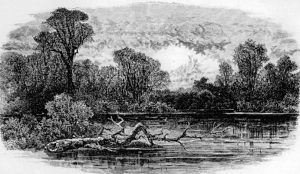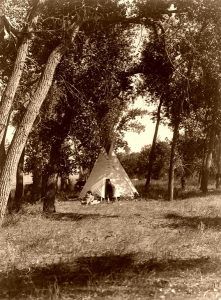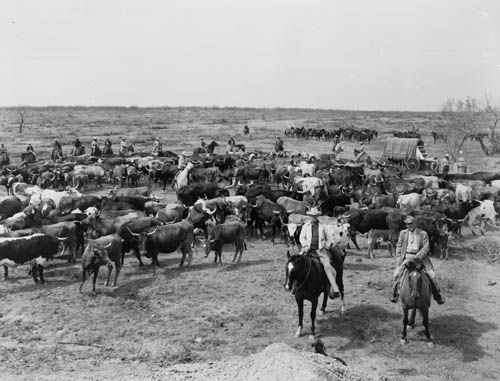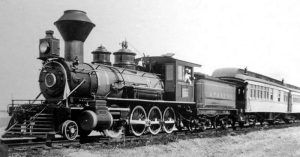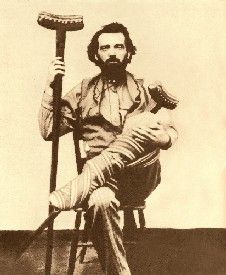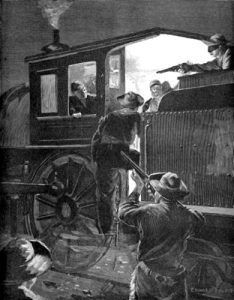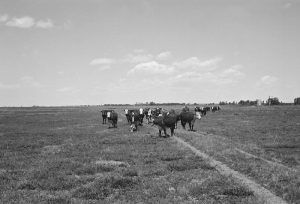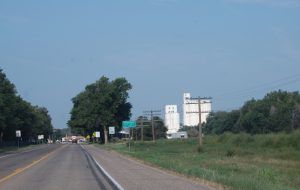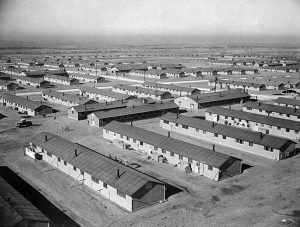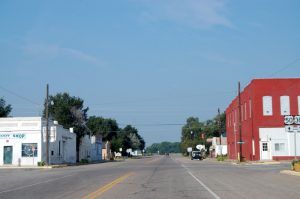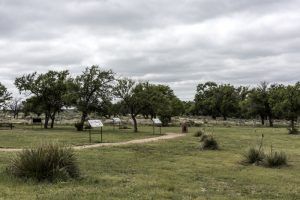Granada, Colorado, was two separate towns on the old Santa Fe Trail in southeastern Colorado. The first town, now called “Old Granada,” was located south of the Arkansas River, about three miles east of the present-day town of Granada.
Old Granada
Located about 12 miles west of the Kansas–Colorado border, this site was on the eastern side of the Big Timbers area, a heavily wooded expanse of giant cottonwood trees that ran about 40 miles along the Arkansas River between Granada and Lamar, Colorado.
The Comanche, Cheyenne, Arapaho, Kiowa, and Apache who frequented the Arkansas River Valley at the time of Euro-American contact were nomadic hunters who depended heavily on bison. Some tribes wintered in the “Big Timbers” of the Arkansas River floodplain near Granada and Lamar. A visitor described the area:
“Buffalo were plentiful, and Indians gathered there in force. A big camp of Cheyenne had pitched their lodges near the log houses of the traders; two miles below, on the north side of the river, was the Arapaho village; on the south bank, opposite the trading houses, were the camps of the Kiowa and Prairie Apache, while farther down on the south side the northern bands of Comanche had gone into winter camp. At night, when the soldier societies were giving dances, the drums could be heard beating in the camps all night long. In the daytime, the trading houses were crowded with Indians bringing in their robes to trade. The Cheyenne and Arapaho women brought their robes on their own backs, but the women from the camps on the other side of the river brought theirs on the backs of mules and horses.”
Explorer, Zebulon Pike, passed through the area in 1806 and described the dense forest of cottonwood along the Arkansas River. Part of Stephen Long’s expedition of 1820 passed through the Arkansas River Valley, as did John C. Fremont in 1844, 1845, and 1853, John Albert in 1845, and John Gunnison in 1854.
In the early days of the Santa Fe Trail, there were two trading posts in the Big Timbers area, one operated by William Bent in 1844 and another by William Tharp in 1846. Other fur traders who worked in the area included Alexander Barclay, Blackfeet John Smith, and Lewis Garrard. The Old Granada site was a favorite campground of travelers along the trail.
Between 1864-1895, this area became “cattle country” when an estimated over 10 million head of Texas Longhorns were driven through the area by over 40,000 cowboys.
The Southern Overland Mail and Express Company stage line began operating through the Arkansas River Valley in 1866 and continued until it was replaced by the railroads.
In 1871 when Colonel R. I. Dodge of Fort Dodge, Kansas, rode through the area, he reported that he saw some 500,000 buffalo.
In 1872, in anticipation of the coming of the railroad, a man by the name of T.B. Nolan opened a general store and commissary on the site of Old Granada and the Chick, Brown & Co. of Kit Carson, a mercantile firm, began laying out a town.
In December 1872, the Atchison, Topeka & Santa Fe Railroad reached the Colorado border and, in May 1873, reached the town. At that time, Granada became an end-of-track town for two years, and most of the traffic along the Santa Fe Trail was diverted to the Granada-Fort Union Wagon Road, through Prowers, Baca, and Las Animas Counties of Colorado to Fort Union, New Mexico, where it joined the Santa Fe Trail.
Within two weeks of the railroad’s arrival, the town boasted three restaurants and a hotel. The town was platted in June 1873, and a post office was established in August 1873, taking its name from nearby Granada Creek. Another large mercantile also moved from Kit Carson to Granada — that of the Otero, Sellars & Co. The two large mercantile companies moved tons of freight to Santa Fe by ox teams.
Over the next two years, Granada entered into competition with West Las Animas, where the Kansas Pacific Railroad had laid its tracks, for the commission and freighting business with Santa Fe and other points in New Mexico. The town would grow dramatically to some 1,500 residents. It would support a public school, two hotels, three grocery stores, a drug store, Wright & Rath’s Hide Buyers, two mercantile companies, four saloons, three dance halls, one gambling hall, and several restaurants. It also boasted an irrigation canal, and coal oil lamps lighted its streets. Even though it was the second largest town in Bent County (Prowers County wasn’t created until 1889) and one of the largest in the state by 1876, Granada was never incorporated, had no legislative body or law enforcement, and supported no newspapers or churches.
During these early days, the town was populated mostly by railroad employees, gamblers, buffalo hunters, freight handlers, and cowboys who worked the nearby ranches. Several Old West characters were in and out of the town during this time. These included Mysterious Dave Mather, Charles White, Doc Holiday, “Chalk” Beeson, Frank Boggs, George Corry, Clay Allison, Jack Allen, Charles Bassett, Ben Thompson, and Ed Masterson. Calamity Jane was a resident of Granada in 1874-1876.
The coming of the railroad brought buffalo hunters by the dozens, and at times, numerous freight wagons could be seen camped at or near Granada, from which the hides were shipped eastward. By 1880, the buffalo were gone from the area.
In 1876, the New Goodnight Trail, which began at Fort Sumner, New Mexico, made its way to Granada. In December 1875, the Atchison, Topeka, and Santa Fe Railroad terminus moved west to La Junta, Colorado and Granada’s glory days ended. By the following year, Granada began to decline as settlers and businessmen moved away. However, It continued to support a post office, the railroad station, a school, a hotel, a store, saloons, and several houses for another decade.
In 1882, two back-to-back train robberies occurred near Granada. On September 30, the westbound passenger train on the Atchison, Topeka & Santa Fe railroad was stopped by the danger signal just after it had left the town. It was then boarded by a large party of armed and masked men, some of whom went directly to the express car and others who robbed the passengers. About $2,000 was taken from the express car and an unknown amount from the passengers. A posse immediately tracked the desperados, but the criminals escaped.
A few weeks later, another train robbery occurred in October, again on the Atchison, Topeka & Santa Fe Railroad. The masked men were waiting for the eastbound train on the side track, and this time made off with $5,500 from the express car but were stopped from robbing the passengers by two sheriffs from Raton and Las Vegas, New Mexico. The robbers, however, missed a safe in the smoking car that contained $10,000.
In 1886, the town was surrounded by lands owned by the Chick, Brown, and Company and various ranches. At that time, entrepreneur Frederick H. Harvey, who owned the famous Harvey House restaurants and hotels, purchased 100,000 acres of Colorado grazing lands for his large herd of cattle. These cattle not only fed the customers of his restaurants, but Harvey also had the contract to feed the passengers along the Atchison, Topeka & Santa Fe Railroad. Called the XY Ranch, the land surrounded Old Granada.
At the same time, the town of Granada wanted to grow, and local businessmen asked Fred Harvey if he would sell some of his lands so that the town could expand. However, Harvey declined, and the businessmen decided to move the entire town three miles to the west. The Bent County Town Company purchased the new site in April 1886. Many of the buildings moved from the old site, but the surveyors borrowed the plat. In the meantime, the site of Old Granada was also sold to the XY Ranch. Today, there are no remains of the once flourishing town.
New Granada
The post office moved with the rest of the town, and the railroad station remained at Old Grenada on the XY Ranch. At that point, the Santa Fe Railroad renamed the station Adana. The town fathers suggested that the Santa Fe Railroad officials move the station from Old Grenada to New Granada. However, the town leaders refused when the railroad demanded 51% of all unsold lots and 51% of the money already received on lot sales in the new town. As a result, the Santa Fe Railroad established a station at Lamar, Colorado, in 1886.
The First National Bank of Granada was the first bank in the area, and the first hotel, known as Mim’s House, was opened in 1886. One of the first orders of business for the town was to establish a school. A seldom-used schoolhouse east of Granada on the XY Ranch was moved to the new site of Granada. After it was moved, it was added on to, and the first teacher was C.O. Barton. The “new” town was incorporated in July 1887, and the Santa Fe Railroad installed a train station in September.
For a few years, the new town of Granada continued its frontier ways with several saloons and frequent gunplay.
In 1889, Prowers County was formed from Bent County, and though Granada vied for the title, it went to Lamar instead.
In 1893, two major fires destroyed most of the business district. Most of the buildings involved had been moved from Old Granada. Many of the business owners who were burned out chose not to rebuild and moved away.
The Colorado Telephone Company constructed a telephone exchange in March 1903, and by June, 50 phones were working in the town. The same year, Granada’s first high school was built.
Another fire that started in the Exchange Saloon destroyed the business district in September 1910.
By 1917, two railroads were passing through the Arkansas River Valley — the Santa Fe to the south of the river and the Arkansas Valley Railroad to the north of the river. U.S. Highway 50 was paved through the area in 1940.
After the Japanese attack on Pearl Harbor on December 7, 1941, during World War II, the US government began relocating Japanese Americans, especially those on the West Coast, to inland internment camps. The Amache Camp, one of ten camps across the country, opened on August 27, 1942, just southwest of Granada. It was named Camp Amache in honor of Amache Ochinee Prowers, the Cheyenne wife of John W. Prowers, for whom the county was named. By September 30, 1942, the center was full with a population of 7,318 citizens. The 60-acre camp was self-supporting and included a post office, fire station, police, schools, churches, a movie theater, and a 150-bed hospital. The Amache residents lived in military-style barracks with rudimentary furnishings and ate together in cafeterias. Adjacent to the camp was a 10,000-acre farm for raising livestock and produce.
Upon the detainees’ arrivals, they often described the camp as “barren,” “stark,” and “desolate.” The setting was very different from that which they had left in California, and one evacuee recalled:
“When I first saw Granada, I thought, ‘My God, is this it, or is this just another rest stop.’ I had never seen such a desolate place in all my life. There just seemed to be no one living there. But after a while, I realized there wouldn’t be anyone there to hassle us like they did back home, so that part of it would be okay.”
In January 1945, the detainment order expired, and most detainees left the facility by October. Amache officially closed on January 27, 1946, its buildings were auctioned off, and the agricultural lands reverted to private farming and ranching.
The Amache site was listed on the National Register of Historic Places in May 1994 and designated a National Historic Landmark in February 2006. Today there is little evidence of the once-thriving community that added to Granada’s existence. The Amache Museum, which interprets the camp, is located at 105 East Goff and in Granada and is open during the summer. Here, a map and brochure can be picked up for self-guided driving tours of Amache. At the site, the buildings are gone, and the grass grows over the foundations of the barracks. Interpretive signs, a small memorial, and the camp cemetery are all that remain of this once busy camp.
Afterward, and continuing through today, Granada became a quiet agricultural community. Today, it is called home to just about 500 people. Many of its business buildings stand empty, testifying to more prosperous times.
© Kathy Weiser-Alexander/Legends of America, updated November 2021.
Also See:
Granada-Fort Union Military Road
Mountain Branch of the Santa Fe Trail
Santa Fe Trail – Highway to the Southwest
Sources:
52 Ancestors
American Local History Network
Central Washington University
National Park Service
Work Progress Administration, Colorado, a Guide to the Highest State, 1941

